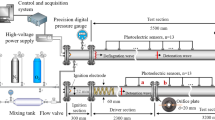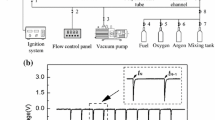Abstract
Re-initiation of detonation in a concentric tube arrangement where a detonation exiting from a small diameter inner tube to a large diameter outer tube has been investigated. The outer tube diameter D is 50.8 mm and inner tube diameters d are 38, 25.4, and 12.7 mm giving diameter ratios \(D/d=1.34\), 2, and 4. Stoichiometric C\(_2\)H\(_2\)–O\(_2\) mixtures with argon dilution of 0, 25, 50, and 70% are used in the present study. Velocity measurements are made using photodiodes, and smoked foils downstream of the exit of the inner tube are also used to record the re-initiation process. Upon exit from the inner tube, the detonation suffers an abrupt decrease in velocity and at critical conditions, the velocity downstream of the exit is of the order of 50% of the Chapman–Jouguet velocity. It is found that re-initiation generally occurs within 10 tube diameters downstream of the exit. If re-initiation is not successful, the detonation continues to propagate at a low velocity for distances of the order of 30 tube diameters without any indication of flame acceleration of deflagration-to-detonation transition (DDT). Thus, the re-initiation process is clearly defined and distinct from the usual DDT in a smooth tube. The critical \(d/\lambda \) value ratio in the concentric tube is significantly lower than the usual unconfined case of \(d/\lambda =13\) where \(\lambda \) is the detonation cell size. Thus, it is a result of re-initiation at the Mach stem of the reflected shock from the wall of the outer concentric tube. If re-initiation is not successful upon the first reflection, then subsequent multiple reflections at the tube axis and wall of the outer tube can also result in re-initiation. However, this is only observed for undiluted mixtures. For high-argon-diluted mixtures, re-initiation only occurs at the Mach stem of the first reflection.









Similar content being viewed by others
References
Laffitte, P.: On the propagation of a spherical explosion wave. Com. Rend. Acad. Sci 177, 178–180 (1923)
Zeldovich, Y.B., Kogarko, S.M., Simonov, N.N.: An experimental investigation of spherical detonation in gases. Sov. Phys. Tech. Phys. 1(8), 1689–1713 (1956)
Mitrofanov, V.V., Soloukhin, R.I.: The diffraction of multifront detonation waves. Sov. Phys. Dokl. 9, 1055 (1965)
Edwards, D.H., Thomas, G.O., Nettleton, M.A.: The diffraction of a planar detonation wave at an abrupt area change. J. Fluid Mech. 95(1), 79–96 (1979)
Knystautas, R., Lee, J.H.S., Guirao, C.M.: The critical tube diameter for detonation failure in hydrocarbon-air mixtures. Combust. Flame 48, 63–83 (1982)
Moen, I.O., Sulmistras, A., Thomas, G.O., Bjerketvedt, D., Thibault, P.A.: Influence of cellular regularity on the behavior of gaseous detonations. Prog. Astronaut. Aeronaut. 106, 220–243 (1986)
Lee, J.H.S.: Dynamic parameters of gaseous detonations. Annu. Rev. Fluid Mech. 16(1), 311–336 (1984)
Desbordes, D.: Transmission of overdriven plane detonations—critical diameter as a function of cell regularity and size. Prog. Astronaut. Aeronaut. 114, 170–185 (1988)
Teodorczyk, A., Lee, J.H.S., Knystautas, R.: Propagation mechanism of quasi-detonations. Proc. Combust. Inst. 22(1), 1723–1731 (1989)
Ciccarelli, G., Dorofeev, S.: Flame acceleration and transition to detonation in ducts. Prog. Energy Combust. Sci. 34(4), 499–550 (2008)
Bhattacharjee, R.R., Lau-Chapdelaine, S.S.M., Maines, G., Maley, L., Radulescu, M.I.: Detonation re-initiation mechanism following the Mach reflection of a quenched detonation. Proc. Combust. Inst. 34(2), 1893–1901 (2013)
Lv, Y., Ihme, M.: Computational analysis of re-ignition and re-initiation mechanisms of quenched detonation waves behind a backward facing step. Proc. Combust. Inst. 35(2), 1963–1972 (2015)
Grondin, J.-S., Lee, J.H.S.: Experimental observation of the onset of detonation downstream of a perforated plate. Shock Waves 20(5), 381–386 (2010)
Ng, H.D., Radulescu, M.I., Higgins, A.J., Nikiforakis, N., Lee, J.H.S.: Numerical investigation of the instability for one-dimensional Chapman–Jouguet detonations with chain-branching kinetics. Combust. Theor. Model. 9(3), 385–401 (2005)
Ng, H.D., Ju, Y., Lee, J.H.S.: Assessment of detonation hazards in high-pressure hydrogen storage from chemical sensitivity analysis. Int. J. Hydrog. Energy 32(1), 93–99 (2007)
Zhang, B., Ng, H.D., Lee, J.H.S.: The critical tube diameter and critical energy for direct initiation of detonation in C\(_2\)H\(_2\)/N\(_2\)O/Ar mixtures. Combust. Flame 159(9), 2944–2953 (2012)
Zhang, B., Bai, C.: Methods to predict the critical energy of direct detonation initiation in gaseous hydrocarbon fuels—an overview. Fuel 117, 294–308 (2014)
Kee, R.J., Rupley, F.M., Miller, J.A.: Chemkin-II: A fortran chemical kinetics package for the analysis of gas-phase chemical kinetics. Technical report SAND-89-8009, Sandia National Labs., Livermore, CA (USA) (1989)
Konnov, A.A.: Development and validation of a detailed reaction mechanism for the combustion of small hydrocarbons. In: 28th International Symposium on Combustion, Edinburgh, UK (2000)
Zhang, B., Mehrjoo, N., Ng, H.D., Lee, J.H.S., Bai, C.: On the dynamic detonation parameters in acetylene–oxygen mixtures with varying amount of argon dilution. Combust. Flame 161(5), 1390–1397 (2014)
Massa, L., Austin, J.M., Jackson, T.L.: Triple-point shear layers in gaseous detonation waves. J. Fluid Mech. 586(1), 205–248 (2007)
Zhang, B., Kamenskihs, V., Ng, H.D., Lee, J.H.S.: Direct blast initiation of spherical gaseous detonations in highly argon diluted mixtures. Proc. Combust. Inst. 33(2), 2265–2271 (2011)
Acknowledgements
This work is supported by the Natural Sciences and Engineering Research Council of Canada (NSERC) and the National Natural Science Foundation of China (Grant No. 11472138). Detailed suggestions and helpful comments by the reviewers are gratefully acknowledged.
Author information
Authors and Affiliations
Corresponding author
Additional information
Communicated by Fan Zhang.
Rights and permissions
About this article
Cite this article
Wu, Y., Lee, J.H.S. & Weng, C. Detonation re-initiation in a concentric tube arrangement for C\(_2\)H\(_2\)/O\(_2\)/Ar mixtures. Shock Waves 27, 375–381 (2017). https://doi.org/10.1007/s00193-016-0698-0
Received:
Revised:
Accepted:
Published:
Issue Date:
DOI: https://doi.org/10.1007/s00193-016-0698-0




